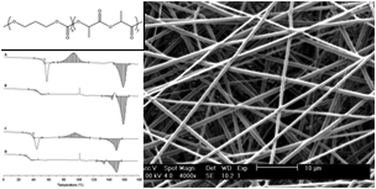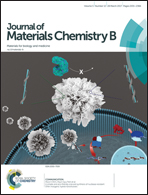Electrospinning and mechanical properties of P(TMC-co-LLA) elastomers†
Abstract
P(TMC-co-LLA) elastomers have shown great potential for various biomaterial and tissue engineering applications. This study systematically investigated properties key to such applications. Three P(TMC-co-LLA) copolymers with 9 to 32 mol% TMC were synthesised and processed into 3D fibrous scaffolds using solution electrospinning. A range of fiber diameters (0.5–5.9 μm) and pore sizes (3.5–19.8 μm) were achieved simply by adjusting the voltage, collector distance and feed rate during electrospinning. The morphological features of the electrospun scaffolds were affected by the copolymer composition such that the average fiber diameters decreased in the order of P(TMC20-co-LLA80) > P(TMC32-co-LLA68) > P(TMC9-co-LLA91), which suggests inherent properties of the copolymers influence the electrospinning process. In addition, the specific parameter combinations applied during electrospinning did not affect the thermal properties of the scaffolds, however, it was confirmed that rapid solidification of the fibers occurred during electrospinning which lowered the inherent crystallinity and caused deviations of the thermodynamic state from equilibrium. Mechanical testing revealed that the Young's modulus and ultimate tensile strength were dependent on the morphology of the fibrous scaffolds, while in contrast, the ductility and toughness were strongly composition dependent with P(TMC20-co-LLA80) scaffolds displaying lower ductility and toughness than P(TMC32-co-LLA68) scaffolds.



 Please wait while we load your content...
Please wait while we load your content...